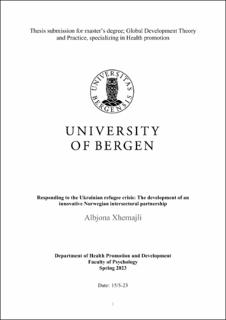Responding to the Ukrainian refugee crisis: The development of an innovative Norwegian intersectoral partnership
Master thesis

View/
Date
2023-05-15Metadata
Show full item recordCollections
- Master theses [157]
Abstract
In 2022, Russia opened war against Ukraine. Consequently, millions of Ukrainians sought refuge across Europe. Amongst others, Norway is one of the countries to receive the Ukrainian refugees. The country experienced a massive ´refugee wave´, more than double the size of previous ´waves´. The urgent situation called for innovative solutions, such as the formation of new partnerships. Normally, the asylum application is reviewed and processed at the national reception centre. However, due to high numbers of incoming refugees and waiting hours at the national centre, this responsibility was decentralized. For many, this was unknown territory. Meaning that local police districts were given full responsibility for the asylum registration process. To make the asylum processes more welcoming and effective, new forms of partnerships were formed between governmental and non-governmental organizations. The largest of the new reception centres in Norway is now in Bergen. Through qualitative measures, this study sets out to explore the emergence and coordination of the new partnership in Vestland. This involves the identification of roles and efforts in a new registration phase, through governmental and non-governmental collaboration. Ten interviews have been conducted with key partners, essential in the organization and reception of Ukrainian refugees at the reception centre in Bergen. The aim is to provide insight of partner processes and functioning´s by applying and utilizing the theoretical framework of Bergen Model of Collaborative Functioning’s (BMCF). Study findings highlight and connect elements of clear roles/structure, leadership, communication, and input interaction as important to successful partnership functioning´s, outlining four recommendations: First, an initial gathering followed by regular meetings where partnering organization can discuss and reflect on the mission. Second, a form of follow up as a means for participants of the partnership to process strong impressions. Third, take opportunities to reflect upon the partnership as a whole to stimulate and create partner synergy and dynamic. Fourth, clear and hands-on leadership to promote partner dynamic and enhance communication, efficacy, and production. Findings suggest that awareness of partnership processes can sustain and promote partnership functioning.